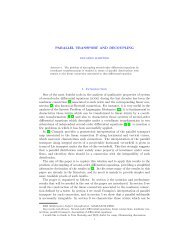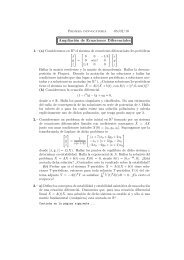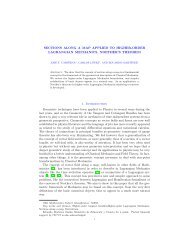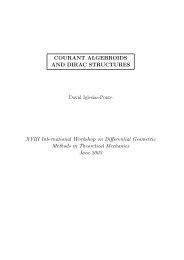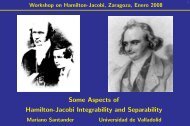TRANSFORMADA DE LAPLACE Estudiamos en este capítulo la ...
TRANSFORMADA DE LAPLACE Estudiamos en este capítulo la ...
TRANSFORMADA DE LAPLACE Estudiamos en este capítulo la ...
Create successful ePaper yourself
Turn your PDF publications into a flip-book with our unique Google optimized e-Paper software.
<strong>TRANSFORMADA</strong> <strong>DE</strong> <strong>LAPLACE</strong> 7<br />
Si f y g son continuas a trozos <strong>en</strong> el intervalo [0, ∞) y ti<strong>en</strong><strong>en</strong> transformada de<br />
Lap<strong>la</strong>ce F y G, respectivam<strong>en</strong>te, <strong>en</strong>tonces <strong>la</strong> transformada de Lap<strong>la</strong>ce del producto<br />
de convolución de f por g es el producto (ordinario) de <strong>la</strong>s sus transformadas, es<br />
decir,<br />
L(f ∗ g)(s) =F (s)G(s).<br />
Por cálculo directo, utilizando el teorema de intercambio de ord<strong>en</strong> de integración,<br />
t<strong>en</strong>emos<br />
� ∞<br />
L(f ∗ g)(s) = e<br />
0<br />
−st (f ∗ g)(t) dt<br />
� ∞<br />
= e<br />
0<br />
−st<br />
�� ∞<br />
�<br />
H(t − τ)f(t − τ)g(τ) dτ dt<br />
� ∞ � ∞<br />
0<br />
= e<br />
0 0<br />
−st H(t − τ)f(t − τ)g(τ) dt dτ<br />
� ∞ �� ∞<br />
= g(τ) e<br />
0<br />
0<br />
−st �<br />
H(t − τ)f(t − τ) dt dτ<br />
� ∞<br />
= g(τ)e<br />
0<br />
−sτ F (s) dτ<br />
� ∞<br />
= F (s) g(τ)e −sτ dτ<br />
0<br />
= F (s)G(s).<br />
donde se ha usado que <strong>la</strong> transformada de Lap<strong>la</strong>ce de H(t−τ)f(t−τ) es e −sτ F (s).<br />
3. Transformada inversa<br />
Nos preguntamos <strong>en</strong> esta sección por <strong>la</strong> posibilidad de que dos funciones distintas<br />
t<strong>en</strong>gan <strong>la</strong> misma transformada de Lap<strong>la</strong>ce. T<strong>en</strong>i<strong>en</strong>do <strong>en</strong> cu<strong>en</strong>ta <strong>la</strong> propiedad de<br />
linealidad de <strong>la</strong> transformada de Lap<strong>la</strong>ce, podemos p<strong>la</strong>ntear el problema de forma<br />
equival<strong>en</strong>te ¿Exist<strong>en</strong> funciones no nu<strong>la</strong>s cuya transformada de Lap<strong>la</strong>ce sea <strong>la</strong> función<br />
cero?. A <strong>este</strong> respecto, recordemos que estamos considerando que dos funciones<br />
continuas a trozos son iguales si difier<strong>en</strong> a lo sumo <strong>en</strong> sus valores <strong>en</strong> los puntos de<br />
discontinuidad <strong>en</strong> [0, ∞).<br />
Teorema 3.1 (Lerch): La única función continua a trozos cuya transformada de<br />
Lap<strong>la</strong>ce es nu<strong>la</strong> (<strong>en</strong> un intervalo semiinfinito) es <strong>la</strong> función cero:<br />
L(f) = 0 si y sólo si f =0.<br />
Dem. Supongamos que S = [s0, ∞) es un intervalo donde F = L(f) es nu<strong>la</strong>.<br />
Integrando por partes ( � u dv = uv − � v du) <strong>en</strong> <strong>la</strong> transformada de f con<br />
obt<strong>en</strong>emos<br />
donde hemos definido<br />
u = e −(s−s0)t<br />
dv = e −s0t f(t) dt,<br />
� ∞<br />
F (s) = (s − s0) e −(s−s0)t<br />
g(t) dt,<br />
0<br />
� t<br />
g(t) = e −s0τ<br />
f(τ) dτ,<br />
0<br />
que es una función continua, y hemos t<strong>en</strong>ido <strong>en</strong> cu<strong>en</strong>ta que g(0) = 0 y que<br />
limt→∞ e−(s−s0)tg(t) = 0 · F (s0) = 0 para s ∈ S.<br />
Como F se anu<strong>la</strong> <strong>en</strong> H, se ti<strong>en</strong>e que F (s0 + n) = 0 para todo n ∈ N, es decir,<br />
� ∞<br />
e −nt g(t) dt.<br />
0




